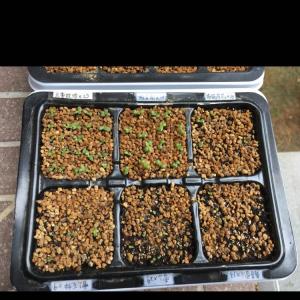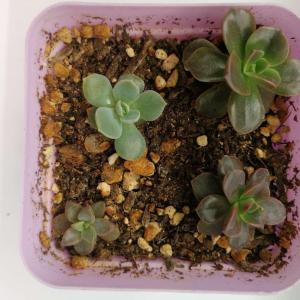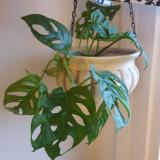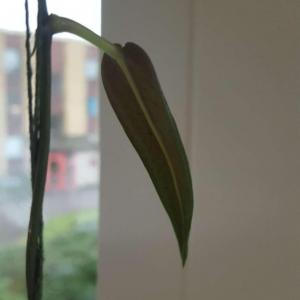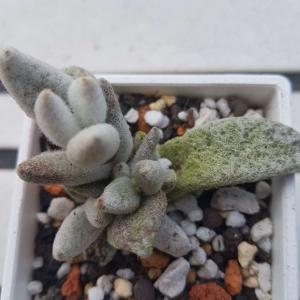文章
Miss Chen
2018年01月11日

Description: This herbaceous perennial plant consists of a rosette of basal leaves. The mature leaves are about 3-5" across, palmately lobed, and orbicular or slightly cordate in shape. Their margins are coarsely serrate or dentate, often with straight white hairs along the major veins on the underside of each leaf. The petioles are longer than the leaves. They have straight white hairs that are quite long and conspicuous. From the center of the rosette emerge several flowering stems that are 2-4' tall. These stems are without leaves and have straight white hairs like the petioles. Each stem terminates in a narrow panicle of green flowers. Sometimes the flowers have reddish tints when exposed to the sun. Each flower is about 1/8" (3 mm.) long, consisting of a bottle-shaped calyx that is divided into 5 lobes. There are 5 inconspicuous petals within the calyx, while 5 stamens with orange anthers are exerted beyond the calyx. The blooming period is usually early summer, and lasts about a month. There is no floral scent. Small capsules develop, containing tiny unwinged seeds, which are dispersed by the wind. The central root stock is stout and short, dividing into coarse roots.
Cultivation: The preference is light shade to full sun, and mesic to dry conditions. This plant prefers rocky soil, but will grow in clay-loam,loam, or sandy soil. Once established, it is an easy plant to grow.
Range & Habitat: The native Prairie Alumroot occurs occasionally in the northern 2/3 of Illinois, but is rare or absent in southern Illinois (see Distribution Map). Habitats include upland areas of black soil prairies, hill prairies, gravel prairies, sand prairies, limestone glades, and rocky upland woodlands. Generally, Prairie Alumroot favors areas with poor rocky soil where there is reduced competition from taller plants.
Faunal Associations: Small bees pollinate the flowers, including Halictid bees and Plasterer bees (Colletidae). The seeds are too small to be of any interest to birds, while the relationship of this plant to mammals is uncertain.

Photographic Location: The photographs were taken at the edge of the postage stamp prairie of Dave Monk in Champaign, Illinois. This plant was underneath a small tree.
Comments: This plant has a similar appearance to Heuchera americana (Common Alumroot). Generally, Prairie Alumroot has straight white hairs on the petioles of the leaves and the flowering stems, while Common Alumroot has short appressed hairs (lying against the flowering stems or petioles), or is devoid of conspicuous hairs. The flowers of Prairie Alumroot are slightly larger in size (about 1/8" or 3 mm. long), while those of Common Alumroot are about 1/10" (2.5 mm.) long. The flowers of Prairie Alumroot are often longer at the top than the bottom, while those of Common Alumroot are more symmetrical. Across different localities, there are significant variations in the characteristics of this plant, and different varieties have been identified. In Illinois, var. grayana has flowers that are strongly asymmetric, while var. affinis (as illustrated in a photograph above) has flowers that are only slightly asymmetric. Plants with reddish leaves and silver markings have been introduced by the nursery trade, which are sometimes grown in flower gardens. The wild plant, however, isn't very showy.
Cultivation: The preference is light shade to full sun, and mesic to dry conditions. This plant prefers rocky soil, but will grow in clay-loam,loam, or sandy soil. Once established, it is an easy plant to grow.
Range & Habitat: The native Prairie Alumroot occurs occasionally in the northern 2/3 of Illinois, but is rare or absent in southern Illinois (see Distribution Map). Habitats include upland areas of black soil prairies, hill prairies, gravel prairies, sand prairies, limestone glades, and rocky upland woodlands. Generally, Prairie Alumroot favors areas with poor rocky soil where there is reduced competition from taller plants.
Faunal Associations: Small bees pollinate the flowers, including Halictid bees and Plasterer bees (Colletidae). The seeds are too small to be of any interest to birds, while the relationship of this plant to mammals is uncertain.

Photographic Location: The photographs were taken at the edge of the postage stamp prairie of Dave Monk in Champaign, Illinois. This plant was underneath a small tree.
Comments: This plant has a similar appearance to Heuchera americana (Common Alumroot). Generally, Prairie Alumroot has straight white hairs on the petioles of the leaves and the flowering stems, while Common Alumroot has short appressed hairs (lying against the flowering stems or petioles), or is devoid of conspicuous hairs. The flowers of Prairie Alumroot are slightly larger in size (about 1/8" or 3 mm. long), while those of Common Alumroot are about 1/10" (2.5 mm.) long. The flowers of Prairie Alumroot are often longer at the top than the bottom, while those of Common Alumroot are more symmetrical. Across different localities, there are significant variations in the characteristics of this plant, and different varieties have been identified. In Illinois, var. grayana has flowers that are strongly asymmetric, while var. affinis (as illustrated in a photograph above) has flowers that are only slightly asymmetric. Plants with reddish leaves and silver markings have been introduced by the nursery trade, which are sometimes grown in flower gardens. The wild plant, however, isn't very showy.
0
0
文章
Miss Chen
2018年01月11日

Description: This perennial plant is 3-5' tall, branching occasionally and becoming rather bushy in open situations. The stems are light green to reddish green, variably pubescent or hairy, and terete to slightly angular. Pairs of opposite leaves are distributed evenly along these stems. These leaves are 2½–5" long and 1–3½" across; they are cordate-ovate, ovate, or lanceolate in shape, while their margins are coarsely serrated. The upper leaf surface is medium to dark green and usually rough-textured from minute stiff hairs, while the lower leaf surface is light green and glabrous to short-pubescent. Primary veins of the leaves are pinnately arranged. On each leaf, 2 prominent lateral veins become separated from the central vein near its base. Secondary veins of the leaves form reticulated networks that are visible on the leaf undersides. The petioles are up to ¾" long, partially winged, and more or less pubescent. The upper stems terminate in flowerheads spanning about 1½–3" across; these flowerheads are usually more or less erect. Each flowerhead consists of 8-20 ray florets that surround numerous disk florets. The petaloid rays of each flowerhead are yellow to deep golden yellow, oblong or oblong-elliptic in shape, and slightly notched at their tips.
The tiny corollas of both the ray florets and disk florets are short-tubular in shape, deep golden yellow to orange-yellow, and 5-lobed; the corolla lobes of these florets are triangular in shape and spreading to recurved. Both the ray florets and disk florets of the flowerheads are fertile. At the base of each flowerhead, there are several outer phyllaries (floral bracts) that are arranged in a single series. These phyllaries are light to medium green, more or less pubescent, and oblong-ovate in shape, tapering abruptly to blunt tips that are somewhat recurved. There are also several inner phyllaries that are arranged in a single series. These phyllaries are similar to the outer phyllaries, but their tips are appressed along the base of the flowerhead, rather than recurved. The peduncles of the flowerheads are 1-6" long, light green, terete to slightly angular, and more or less pubescent. The blooming period occurs from early summer to late summer, lasting about 2-3 months for a colony of plants. Afterwards, the florets are replaced by achenes that are 4-5 mm. long, oblongoid-oblanceoloid in shape, somewhat flattened, and dark-colored. These achenes lack tufts of hair, nor do they have significant scales at their apices. The root system is fibrous.

Cultivation: The preference is full to partial sun, moist to mesic conditions, and loamy soil, although rocky ground and clay-loam are tolerated. This plant is easy to cultivate and it has a long blooming period during the summer. Some double-flowered cultivars are available.
Range & Habitat: The native False Sunflower occurs throughout Illinois, except for a few southern counties (see Distribution Map). It is a fairly common plant, favoring areas that have some history of disturbance. Habitats include black soil prairies, river-bottom prairies, grassy meadows in wooded areas, open woodlands, woodland borders, savannas, thickets, limestone glades, banks of streams, and areas along railroads where prairie remnants occur. False Sunflower is grown in flower gardens, from which it sometimes escapes into neighboring waste areas. This plant is also used in prairie restorations, even though it is more typically found in or around wooded areas.

Faunal Associations: The nectar and pollen of the flowerheads attract a wide variety of insects, including honeybees, bumblebees, little carpenter bees (Ceratina spp.), digger bees (Melissodes spp.), cuckoo bees (Coelioxys spp., Triepeolus spp.), leaf-cutting bees (Megachile spp.), Halictid bees (Agapostemon spp., Lasioglossum spp.), Andrenid bees (Andrena spp., Heterosarus spp.), thread-waisted wasps (Ammophila spp.) and other wasps, Syrphid flies (Eristalis spp., Toxomerus spp.), bee flies (Exoprosopa spp.), the Goldenrod Soldier Beetle (Chauliognathus pennsylanicus) and other beetles, Painted Lady butterflies (Vanessa spp.) and other butterflies, and skippers (Robertson, 1929). These floral visitors cross-pollinate the flowerheads. Other insects feed on the leaves, stems, seeds, and other parts of False Sunflower. These species include a leaf beetle (Physonota helianthi), leaf-mining larvae of a Tischeriid moth (Astrotischeria heliopsisella), stem-boring larvae of the Rigid Sunflower Borer Moth (Papaipema rigida), floret- and seed-eating larvae of a fly (Melanagromyza virens), and a seed bug (Lygaeus turcicus); see Clark et al. (2004), Microleps website (2010), Covell (1984/2005), Marcovitch (1916), and Hoffman (1996). Little is known about this plant's relationships to vertebrate animals, but they are probably similar to those of sunflowers (Helianthus spp.). Hoofed mammalian herbivores probably browse on the young foliage, while upland gamebirds, granivorous songbirds, and small rodents probably eat the seeds.

Photographic Location: The photographs were taken at Kaufman Lake Park in Champaign, Illinois, near some trees.
Comments: False Sunflower (Heliopsis helianthoides) is not considered a true sunflower (Helianthus sp.) because both the ray and disk florets of its flowerheads can produce seeds. In contrast, only the disk florets of sunflowers can produce seeds. In contrast to both False Sunflower and true sunflowers, only the ray florets of Silphium spp. can produce seeds, while their disk florets are seedless. All of these species are relatively large and robust plants that produce showy flowerheads with yellow rays, and they prefer habitats that are at least partly sunny. False Sunflower resembles many sunflower species, particularly those that are found in and around woodlands. In addition to the difference in the fertility of their florets, False Sunflower can be distinguished by its more erect flowerheads, by the rather stout and blunt-tipped phyllaries on its flowerheads, and by the arrangement of its outer phyllaries in a single series. In contrast, most sunflower species have flowerheads that nod sideways, their phyllaries are either more slender (linear-lanceolate in shape) or they are triangular with acute tips, and they have several overlapping series of outer phyllaries.
The tiny corollas of both the ray florets and disk florets are short-tubular in shape, deep golden yellow to orange-yellow, and 5-lobed; the corolla lobes of these florets are triangular in shape and spreading to recurved. Both the ray florets and disk florets of the flowerheads are fertile. At the base of each flowerhead, there are several outer phyllaries (floral bracts) that are arranged in a single series. These phyllaries are light to medium green, more or less pubescent, and oblong-ovate in shape, tapering abruptly to blunt tips that are somewhat recurved. There are also several inner phyllaries that are arranged in a single series. These phyllaries are similar to the outer phyllaries, but their tips are appressed along the base of the flowerhead, rather than recurved. The peduncles of the flowerheads are 1-6" long, light green, terete to slightly angular, and more or less pubescent. The blooming period occurs from early summer to late summer, lasting about 2-3 months for a colony of plants. Afterwards, the florets are replaced by achenes that are 4-5 mm. long, oblongoid-oblanceoloid in shape, somewhat flattened, and dark-colored. These achenes lack tufts of hair, nor do they have significant scales at their apices. The root system is fibrous.

Cultivation: The preference is full to partial sun, moist to mesic conditions, and loamy soil, although rocky ground and clay-loam are tolerated. This plant is easy to cultivate and it has a long blooming period during the summer. Some double-flowered cultivars are available.
Range & Habitat: The native False Sunflower occurs throughout Illinois, except for a few southern counties (see Distribution Map). It is a fairly common plant, favoring areas that have some history of disturbance. Habitats include black soil prairies, river-bottom prairies, grassy meadows in wooded areas, open woodlands, woodland borders, savannas, thickets, limestone glades, banks of streams, and areas along railroads where prairie remnants occur. False Sunflower is grown in flower gardens, from which it sometimes escapes into neighboring waste areas. This plant is also used in prairie restorations, even though it is more typically found in or around wooded areas.

Faunal Associations: The nectar and pollen of the flowerheads attract a wide variety of insects, including honeybees, bumblebees, little carpenter bees (Ceratina spp.), digger bees (Melissodes spp.), cuckoo bees (Coelioxys spp., Triepeolus spp.), leaf-cutting bees (Megachile spp.), Halictid bees (Agapostemon spp., Lasioglossum spp.), Andrenid bees (Andrena spp., Heterosarus spp.), thread-waisted wasps (Ammophila spp.) and other wasps, Syrphid flies (Eristalis spp., Toxomerus spp.), bee flies (Exoprosopa spp.), the Goldenrod Soldier Beetle (Chauliognathus pennsylanicus) and other beetles, Painted Lady butterflies (Vanessa spp.) and other butterflies, and skippers (Robertson, 1929). These floral visitors cross-pollinate the flowerheads. Other insects feed on the leaves, stems, seeds, and other parts of False Sunflower. These species include a leaf beetle (Physonota helianthi), leaf-mining larvae of a Tischeriid moth (Astrotischeria heliopsisella), stem-boring larvae of the Rigid Sunflower Borer Moth (Papaipema rigida), floret- and seed-eating larvae of a fly (Melanagromyza virens), and a seed bug (Lygaeus turcicus); see Clark et al. (2004), Microleps website (2010), Covell (1984/2005), Marcovitch (1916), and Hoffman (1996). Little is known about this plant's relationships to vertebrate animals, but they are probably similar to those of sunflowers (Helianthus spp.). Hoofed mammalian herbivores probably browse on the young foliage, while upland gamebirds, granivorous songbirds, and small rodents probably eat the seeds.

Photographic Location: The photographs were taken at Kaufman Lake Park in Champaign, Illinois, near some trees.
Comments: False Sunflower (Heliopsis helianthoides) is not considered a true sunflower (Helianthus sp.) because both the ray and disk florets of its flowerheads can produce seeds. In contrast, only the disk florets of sunflowers can produce seeds. In contrast to both False Sunflower and true sunflowers, only the ray florets of Silphium spp. can produce seeds, while their disk florets are seedless. All of these species are relatively large and robust plants that produce showy flowerheads with yellow rays, and they prefer habitats that are at least partly sunny. False Sunflower resembles many sunflower species, particularly those that are found in and around woodlands. In addition to the difference in the fertility of their florets, False Sunflower can be distinguished by its more erect flowerheads, by the rather stout and blunt-tipped phyllaries on its flowerheads, and by the arrangement of its outer phyllaries in a single series. In contrast, most sunflower species have flowerheads that nod sideways, their phyllaries are either more slender (linear-lanceolate in shape) or they are triangular with acute tips, and they have several overlapping series of outer phyllaries.
0
0
文章
Miss Chen
2018年01月10日

Description: This perennial plant is 3-12' tall. Plants in dense colonies are only 3-5' tall, but 'lone wolf' plants can achieve considerable height. The stout central stem is glabrous, glaucous, terete (circular in cross-section), and often reddish or reddish-purple in color. There is very little branching, except for some flowering stems that occur along the upper half of the plant. The leaves are up to 8" long and 2½" across, lanceolate-oblong, and either smooth (entire) or slightly to strongly serrate along their margins. The upper leaf surface is medium to dark green with a sandpapery texture that derives from the presence of minute stiff hairs. The lower leaf surface is pale green and softly hairy. The leaves are often slightly recurved, and they have a tendency to fold upward along their central veins, particularly during hot dry weather. The leaves are opposite below, but they become either alternate or opposite along the upper half of the plant. The leaves taper gradually into slender petioles that are about ½" in length.
The upper stems terminate into either individual or small clusters of flowerheads. Each flowerhead is 2½-4" across, consisting of 10-20 ray florets that surround numerous disk florets. The tiny corollas of the disk florets are tubular-shaped and yellow, while the petaloid rays along the circumference of the flowerhead are bright yellow and oblong in shape. Around the base of each flowerhead, there are floral bracts (phyllaries) that are arranged in several overlapping series. These bracts are light green and linear-lanceolate in shape, becoming slightly recurved when the flowerhead blooms. On a large plant, it is not uncommon for several flowerheads to be bloom at the same time. The blooming period occurs from late summer to fall, lasting about 1-2 months. The disk florets are replaced by achenes about 3-4 mm. in length that are oblongoid and somewhat flattened in shape. The root system is fibrous and rhizomatous, often forming clonal colonies of variable size.
Cultivation: The preference is full sun, moist soil, and fertile loamy soil with high organic content. However, this robust plant will tolerated other kinds of soil. Powdery mildew may affect the leaves, but this typically occurs during the fall after the blooming period. Strong wind can cause this plant to blow over in exposed situations. It also requires lots of room because of its large (sometimes huge) size and aggressive tendencies.

Range & Habitat: The native Sawtooth Sunflower occurs throughout most of Illinois, except for a few SE counties (see Distribution Map). It is a common plant. Habitats include moist to mesic black soil prairies, thickets, moist meadows near rivers or lakes, Bur Oak savannas, bases of bluffs, fence rows, and areas along ditches, railroads, and roadsides. Sawtooth Sunflower thrives in both disturbed and high quality sites, sometimes forming large colonies that exclude other plants.
Faunal Associations: The most common visitors to the flowers are bees, especially long-tongued species. Among these are honeybees, bumblebees, Cuckoo bees (Epeolus spp., Triepeolus spp.), digger bees (Melissodes spp.), and leaf-cutting bees (Megachile spp.). Other insect visitors include Syrphid flies, bee flies, butterflies, moths, and beetles. Both nectar and pollen are available as floral rewards. Other insects feed on the foliage, plant juices, pith of stems, developing seeds, etc., of sunflowers. These insect feeders include caterpillars of the butterflies Chlosyne nycteis (Silvery Checkerspot) and Chlosyne gorgone (Gorgone Checkerspot), stem-boring caterpillars of Papaipema necopina (Sunflower Borer Moth) and Papaipema rigida (Rigid Sunflower Borer Moth), seed-eating caterpillars of the moths Homoeosoma electella (Sunflower Moth) and Stibadium spumosum (Frothy Moth), foliage-eating caterpillars of Grammia arge (Arge Tiger Moth) and Phragmatobia fuliginosa (Ruby Tiger Moth), and many other Lepidoptera (see Lepidoptera Table for a more complete listing of these species).

Other insect feeders of sunflowers include the stem-boring larvae of Apion occidentale (Black Sunflower Weevil) and Cylindrocopturus adspersus (Sunflower Stem Weevil), Physonota helianthi (Sunflower Tortoise Beetle) and Systena blanda (Pale-Striped Flea Beetle), larvae of the flies Neotephritis finalis (Sunflower Seed Maggot) and Strauzia longipennis (Sunflower Maggot), Hesperotettix viridis (Meadow Purple-Striped Grasshopper) and Melanoplus femurrubrum (Red-Legged Grasshopper), Aphis helianthi (Sunflower Aphid) and Uroleucon ambrosiae (Brown Ambrosia Aphid), Clastoptera xanthocephala (Sunflower Spittlebug), and many other insects (see Insect Table for a more complete listing of these species). The seeds of sunflowers are a favorite food of such upland gamebirds and songbirds as the Ring-Necked Pheasant, Bobwhite Quail, Mourning Dove, Redwing Blackbird, Eastern Goldfinch, Lark Sparrow, and Savannah Sparrow. Such rodents as the Franklin Ground Squirrel, Prairie Vole, and Meadow Vole also eat the seeds. These animals probably help to spread the seeds into new areas. When the Sawtooth Sunflower and other sunflowers are located near bodies of water, beavers and muskrats sometimes use their stems to construct dams or lodges. Deer, cattle, and other hoofed mammalian herbivores occasionally browse on the foliage of larger sunflower plants, while groundhogs and rabbits are more likely to attack smaller plants.

Photographic Location: The photographs were taken at the Red Bison Railroad Prairie in Savoy, Illinois, and Meadowbrook Park in Urbana, Illinois.
Comments: Notwithstanding its name, the Sawtooth Sunflower often has leaves that are toothless or only slightly serrated. There is considerable variation in the size of plants across different locations, and the leaves are somewhat variable in their size and shape. This sunflower can be distinguished from other Helianthus spp. (sunflowers) by its smooth reddish stems, which often have a powdery white bloom that can rubbed off (i.e., they are glabrous and glaucous). The lower stems on large older plants can become slightly woody in appearance. The Sawtooth Sunflower is similar in size and appearance to Helianthus giganteus (Giant Sunflower), but this latter species has hairy stems and it is usually found in habitats that are more moist and sandy.
The upper stems terminate into either individual or small clusters of flowerheads. Each flowerhead is 2½-4" across, consisting of 10-20 ray florets that surround numerous disk florets. The tiny corollas of the disk florets are tubular-shaped and yellow, while the petaloid rays along the circumference of the flowerhead are bright yellow and oblong in shape. Around the base of each flowerhead, there are floral bracts (phyllaries) that are arranged in several overlapping series. These bracts are light green and linear-lanceolate in shape, becoming slightly recurved when the flowerhead blooms. On a large plant, it is not uncommon for several flowerheads to be bloom at the same time. The blooming period occurs from late summer to fall, lasting about 1-2 months. The disk florets are replaced by achenes about 3-4 mm. in length that are oblongoid and somewhat flattened in shape. The root system is fibrous and rhizomatous, often forming clonal colonies of variable size.
Cultivation: The preference is full sun, moist soil, and fertile loamy soil with high organic content. However, this robust plant will tolerated other kinds of soil. Powdery mildew may affect the leaves, but this typically occurs during the fall after the blooming period. Strong wind can cause this plant to blow over in exposed situations. It also requires lots of room because of its large (sometimes huge) size and aggressive tendencies.

Range & Habitat: The native Sawtooth Sunflower occurs throughout most of Illinois, except for a few SE counties (see Distribution Map). It is a common plant. Habitats include moist to mesic black soil prairies, thickets, moist meadows near rivers or lakes, Bur Oak savannas, bases of bluffs, fence rows, and areas along ditches, railroads, and roadsides. Sawtooth Sunflower thrives in both disturbed and high quality sites, sometimes forming large colonies that exclude other plants.
Faunal Associations: The most common visitors to the flowers are bees, especially long-tongued species. Among these are honeybees, bumblebees, Cuckoo bees (Epeolus spp., Triepeolus spp.), digger bees (Melissodes spp.), and leaf-cutting bees (Megachile spp.). Other insect visitors include Syrphid flies, bee flies, butterflies, moths, and beetles. Both nectar and pollen are available as floral rewards. Other insects feed on the foliage, plant juices, pith of stems, developing seeds, etc., of sunflowers. These insect feeders include caterpillars of the butterflies Chlosyne nycteis (Silvery Checkerspot) and Chlosyne gorgone (Gorgone Checkerspot), stem-boring caterpillars of Papaipema necopina (Sunflower Borer Moth) and Papaipema rigida (Rigid Sunflower Borer Moth), seed-eating caterpillars of the moths Homoeosoma electella (Sunflower Moth) and Stibadium spumosum (Frothy Moth), foliage-eating caterpillars of Grammia arge (Arge Tiger Moth) and Phragmatobia fuliginosa (Ruby Tiger Moth), and many other Lepidoptera (see Lepidoptera Table for a more complete listing of these species).

Other insect feeders of sunflowers include the stem-boring larvae of Apion occidentale (Black Sunflower Weevil) and Cylindrocopturus adspersus (Sunflower Stem Weevil), Physonota helianthi (Sunflower Tortoise Beetle) and Systena blanda (Pale-Striped Flea Beetle), larvae of the flies Neotephritis finalis (Sunflower Seed Maggot) and Strauzia longipennis (Sunflower Maggot), Hesperotettix viridis (Meadow Purple-Striped Grasshopper) and Melanoplus femurrubrum (Red-Legged Grasshopper), Aphis helianthi (Sunflower Aphid) and Uroleucon ambrosiae (Brown Ambrosia Aphid), Clastoptera xanthocephala (Sunflower Spittlebug), and many other insects (see Insect Table for a more complete listing of these species). The seeds of sunflowers are a favorite food of such upland gamebirds and songbirds as the Ring-Necked Pheasant, Bobwhite Quail, Mourning Dove, Redwing Blackbird, Eastern Goldfinch, Lark Sparrow, and Savannah Sparrow. Such rodents as the Franklin Ground Squirrel, Prairie Vole, and Meadow Vole also eat the seeds. These animals probably help to spread the seeds into new areas. When the Sawtooth Sunflower and other sunflowers are located near bodies of water, beavers and muskrats sometimes use their stems to construct dams or lodges. Deer, cattle, and other hoofed mammalian herbivores occasionally browse on the foliage of larger sunflower plants, while groundhogs and rabbits are more likely to attack smaller plants.

Photographic Location: The photographs were taken at the Red Bison Railroad Prairie in Savoy, Illinois, and Meadowbrook Park in Urbana, Illinois.
Comments: Notwithstanding its name, the Sawtooth Sunflower often has leaves that are toothless or only slightly serrated. There is considerable variation in the size of plants across different locations, and the leaves are somewhat variable in their size and shape. This sunflower can be distinguished from other Helianthus spp. (sunflowers) by its smooth reddish stems, which often have a powdery white bloom that can rubbed off (i.e., they are glabrous and glaucous). The lower stems on large older plants can become slightly woody in appearance. The Sawtooth Sunflower is similar in size and appearance to Helianthus giganteus (Giant Sunflower), but this latter species has hairy stems and it is usually found in habitats that are more moist and sandy.
0
0
文章
Miss Chen
2018年01月06日

Description: This perennial wildflower forms a low leafy rosette about 6-10" across. Individual basal leaves are 3-5" long and 1-1¾" across; each leaf is odd-pinnate with 3-6 pairs of lateral leaflets and a terminal leaflet. There are also secondary leaflets that are inserted between some pairs of lateral leaflets; these secondary leaflets are quite small and poorly developed. These leaflets are oriented away from the center of the rosette, forming an oblique angle with the rachis (central stalk of the compound leaf).
Individual leaflets are oblanceolate in shape, shallowly cleft, coarsely dentate, and slightly ciliate along their margins; they are somewhat variable and irregular. During the growing season, the upper leaf surface is medium green and sparsely covered with short appressed hairs, while the lower leaf surface is light green and hairy primarily along the rachis and major veins. Flowering stalks develop from the center of the rosette, becoming 5-10" tall at maturity. Each stalk terminates in an umbel of 3 nodding flowers. The flowering stalks (peduncles) are reddish green to reddish purple, terete, and densely hairy. There is a pair of leafy bracts at the base of each umbel that are deeply cleft with linear to linear-oblong segments. These bracts are reddish green to reddish purple and hairy. Sometimes pairs of leafy bractlets develop along the hairy pedicels of the flowers; these bractlets are also deeply cleft with linear segments. IndividualDistribution Map flowers are ½-1" long and similarly across. Each flower consists of 5 pale red to purplish red sepals, 5 white to pale red petals, a central cluster of pistils, and numerous stamens that are arranged in a ring. The sepals extend along the entire length of the flower and they are joined together at the base; each sepal is deltate in shape and hairy. Each flower also has 5 linear floral bracts (one floral bract between each adjacent pair of sepals). These floral bracts are the same color as the sepals and hairy; they extend outward from the sepals. The petals are largely hidden by the long sepals as the flower barely opens. The blooming period can occur from early to late spring and lasts about 1-2 months. Afterwards, each flower becomes erect and develops a dense cluster of achenes with long feathery tails. These achenes are distributed by the wind. The root system is fibrous and rhizomatous. This wildflower can form small clonal colonies of plants from the rhizomes. A rosette of low basal leaves persists through the winter; these winter leaves are often reddish purple.
Cultivation: The preference is full sun, mesic to dry conditions, and a barren soil that is rocky, gravelly, or sandy. Young plants should be kept well-watered during hot summer weather as Prairie Smoke is adapted to a somewhat cool northern climate. Competition from taller and more aggressive plants is not tolerated.
Range & Habitat: The native Prairie Smoke is restricted to northern Illinois, where it is uncommon. Elsewhere in the state, it is absent. In Illinois, habitats consist of dry gravelly prairies and hill prairies. In other states (e.g., Michigan), this plant has been found in sand prairies and alvars (a habitat that is dominated by limestone slabs). This conservative species is found in high quality prairies where the vegetation is neither too dense nor tall.
Faunal Associations: The flowers are cross-pollinated by bumblebees, which seek primarily nectar from the flowers (personal observation, 2011; Choberka et al., 2000). These insects are strong enough to force their way into the flowers. The adults of a leaf beetle, Graphops marcassita, have been observed to feed on Prairie Smoke (Clark et al., 2004). The larvae of this beetle may also feed on the roots.
Photographic Location: The wildflower garden of the webmaster in Urbana, Illinois.

Comments: Prairie Smoke is an attractive little plant that should be cultivated more often. The reddish flowers remain attractive for 2-3 months during both the blooming period and afterwards as the achenes develop. It is an easy plant to identify because no other Geum sp. (Avens) within Illinois develops achenes with long feathery tails. Only one other species in this genus, Geum rivale (Water Avens), also produces large reddish flowers. However, Water Avens prefers much wetter habitats than Prairie Smoke. Within the state, other species in this genus produce more conventional flowers with 5 spreading petals that are white or yellow.
Individual leaflets are oblanceolate in shape, shallowly cleft, coarsely dentate, and slightly ciliate along their margins; they are somewhat variable and irregular. During the growing season, the upper leaf surface is medium green and sparsely covered with short appressed hairs, while the lower leaf surface is light green and hairy primarily along the rachis and major veins. Flowering stalks develop from the center of the rosette, becoming 5-10" tall at maturity. Each stalk terminates in an umbel of 3 nodding flowers. The flowering stalks (peduncles) are reddish green to reddish purple, terete, and densely hairy. There is a pair of leafy bracts at the base of each umbel that are deeply cleft with linear to linear-oblong segments. These bracts are reddish green to reddish purple and hairy. Sometimes pairs of leafy bractlets develop along the hairy pedicels of the flowers; these bractlets are also deeply cleft with linear segments. IndividualDistribution Map flowers are ½-1" long and similarly across. Each flower consists of 5 pale red to purplish red sepals, 5 white to pale red petals, a central cluster of pistils, and numerous stamens that are arranged in a ring. The sepals extend along the entire length of the flower and they are joined together at the base; each sepal is deltate in shape and hairy. Each flower also has 5 linear floral bracts (one floral bract between each adjacent pair of sepals). These floral bracts are the same color as the sepals and hairy; they extend outward from the sepals. The petals are largely hidden by the long sepals as the flower barely opens. The blooming period can occur from early to late spring and lasts about 1-2 months. Afterwards, each flower becomes erect and develops a dense cluster of achenes with long feathery tails. These achenes are distributed by the wind. The root system is fibrous and rhizomatous. This wildflower can form small clonal colonies of plants from the rhizomes. A rosette of low basal leaves persists through the winter; these winter leaves are often reddish purple.
Cultivation: The preference is full sun, mesic to dry conditions, and a barren soil that is rocky, gravelly, or sandy. Young plants should be kept well-watered during hot summer weather as Prairie Smoke is adapted to a somewhat cool northern climate. Competition from taller and more aggressive plants is not tolerated.
Range & Habitat: The native Prairie Smoke is restricted to northern Illinois, where it is uncommon. Elsewhere in the state, it is absent. In Illinois, habitats consist of dry gravelly prairies and hill prairies. In other states (e.g., Michigan), this plant has been found in sand prairies and alvars (a habitat that is dominated by limestone slabs). This conservative species is found in high quality prairies where the vegetation is neither too dense nor tall.
Faunal Associations: The flowers are cross-pollinated by bumblebees, which seek primarily nectar from the flowers (personal observation, 2011; Choberka et al., 2000). These insects are strong enough to force their way into the flowers. The adults of a leaf beetle, Graphops marcassita, have been observed to feed on Prairie Smoke (Clark et al., 2004). The larvae of this beetle may also feed on the roots.
Photographic Location: The wildflower garden of the webmaster in Urbana, Illinois.

Comments: Prairie Smoke is an attractive little plant that should be cultivated more often. The reddish flowers remain attractive for 2-3 months during both the blooming period and afterwards as the achenes develop. It is an easy plant to identify because no other Geum sp. (Avens) within Illinois develops achenes with long feathery tails. Only one other species in this genus, Geum rivale (Water Avens), also produces large reddish flowers. However, Water Avens prefers much wetter habitats than Prairie Smoke. Within the state, other species in this genus produce more conventional flowers with 5 spreading petals that are white or yellow.
0
0
文章
Miss Chen
2017年12月26日

Description: This perennial plant is 3-4' tall and unbranched, except for the upper flowering stems. The stems are covered with white hairs. The opposite leaves are up to 5" long and 1" across, occasionally with small teeth along the margins. They are usually dark green, lanceolate to narrowly ovate, and pubescent. There are three conspicuous veins that run along the length of each leaf. The rather flat inflorescence consists of numerous heads of small white flowers and their buds. These flowers are dull white and individually only 1/8" (3 mm.) across. There is little or no floral scent. The blooming period occurs from late summer to early fall, and lasts about 1-1½ months. The achenes develop small tufts of white or light brown hair; they are dispersed by the wind. This plant may spread vegetatively through rhizomes.
Cultivation: The preference is full or partial sun, and mesic to dry conditions. The soil can contain significant amounts of loam, clay, or gravel; soil with a high pH is tolerated. Drought tolerance is good, although the plant may wilt. Tall Boneset is very easy to grow, and competes well against other plants. It is usually not affected by foliar disease.
Range & Habitat: The native Tall Boneset occurs in most of Illinois, except some southern counties (see Distribution Map). It is a common plant. Habitats include mesic to slightly dry black soil prairies, clay prairies, gravel prairies, savannas, thickets, openings in upland forests, dry banks of lakes, limestone glades, pastures and abandoned fields, fence rows, vacant lots, and areas along railroads. This plant favors disturbed areas, where it may form large colonies.

Faunal Associations: The nectar of the flowers attracts many kinds of insects, including long-tongued bees, short-tongued bees, wasps, flies, small butterflies, skippers, beetles, and plant bugs. Among these, wasps and flies are particularly common visitors. The wasp visitors include Paper wasps, Thread-Waisted wasps, bee wolves (Philanthus spp.), Scoliid wasps, Larrine wasps, Sand wasps, Spider wasps, and others. Fly visitors include Syrphid flies, bee flies, Tachinid flies, Muscid flies, and others. The caterpillars of several moths feed on various parts of Tall Boneset and closely related plants, including Haploa clymene (Clymene Moth), Phragmatobia lineata (Lined Ruby Tiger Moth), Carmenta bassiformis (Eupatorium Borer Moth; bores into roots), and Schinia trifascia (Three-Lined Flower Moth; eats flowers & seed capsules). Mammalian herbivores, including livestock, shun the bitter-tasting leaves of this plant; consequently, it tends to flourish in pastures.

Photographic Location: The photographs were taken at a flower garden along a sidewalk in Urbana, Illinois, and in a vacant lot near the same city.
Comments: Tall Boneset often competes directly with Solidago canadensis (Canada Goldenrod) in disturbed areas, although it prefers slightly drier areas. The two plants appear similar to each other prior to bloom, although the former has darker leaves. This plant provides some white color to a fall landscape that is often dominated by forbs with yellow flowers and the brown color of dried-out grasses. This is the easiest boneset to grow in dry sunny areas. Some people may mistake this plant for a weed, which it is to some extent.
Cultivation: The preference is full or partial sun, and mesic to dry conditions. The soil can contain significant amounts of loam, clay, or gravel; soil with a high pH is tolerated. Drought tolerance is good, although the plant may wilt. Tall Boneset is very easy to grow, and competes well against other plants. It is usually not affected by foliar disease.
Range & Habitat: The native Tall Boneset occurs in most of Illinois, except some southern counties (see Distribution Map). It is a common plant. Habitats include mesic to slightly dry black soil prairies, clay prairies, gravel prairies, savannas, thickets, openings in upland forests, dry banks of lakes, limestone glades, pastures and abandoned fields, fence rows, vacant lots, and areas along railroads. This plant favors disturbed areas, where it may form large colonies.

Faunal Associations: The nectar of the flowers attracts many kinds of insects, including long-tongued bees, short-tongued bees, wasps, flies, small butterflies, skippers, beetles, and plant bugs. Among these, wasps and flies are particularly common visitors. The wasp visitors include Paper wasps, Thread-Waisted wasps, bee wolves (Philanthus spp.), Scoliid wasps, Larrine wasps, Sand wasps, Spider wasps, and others. Fly visitors include Syrphid flies, bee flies, Tachinid flies, Muscid flies, and others. The caterpillars of several moths feed on various parts of Tall Boneset and closely related plants, including Haploa clymene (Clymene Moth), Phragmatobia lineata (Lined Ruby Tiger Moth), Carmenta bassiformis (Eupatorium Borer Moth; bores into roots), and Schinia trifascia (Three-Lined Flower Moth; eats flowers & seed capsules). Mammalian herbivores, including livestock, shun the bitter-tasting leaves of this plant; consequently, it tends to flourish in pastures.

Photographic Location: The photographs were taken at a flower garden along a sidewalk in Urbana, Illinois, and in a vacant lot near the same city.
Comments: Tall Boneset often competes directly with Solidago canadensis (Canada Goldenrod) in disturbed areas, although it prefers slightly drier areas. The two plants appear similar to each other prior to bloom, although the former has darker leaves. This plant provides some white color to a fall landscape that is often dominated by forbs with yellow flowers and the brown color of dried-out grasses. This is the easiest boneset to grow in dry sunny areas. Some people may mistake this plant for a weed, which it is to some extent.
0
0
文章
Miss Chen
2017年12月26日

Description: This perennial plant is 2-5' tall. It has a stout central stem that is unbranched, except near the inflorescence. The alternate leaves tend to occur near the base of the plant, although a few smaller leaves occur along the upper portion of the stem. These leaves are long and strap-like, rather stiff in texture, and up to 2½' long and 2½" across. They are narrowly lanceolate, often curve downward, and have parallel venation. There are widely scattered, but stiff, teeth along the margins. The base of leaves clasp or wrap around the stalk. The entire plant is bluish or greyish green, and quite hairless. At the apex of the central stem, and sometimes from the axils of the upper leaves, occurs a long-stalked inflorescence. This consists of several prickly balls of flowers that are individually about ½–1" across. These whitish green balls contain numerous small white flowers that are individually surrounded by prickly bracts. A flower consists of 5 white petals, a divided white pistil, and several white stamens with light brown anthers. Each ball of flowers is subtended by a star-like rosette of small leaves. These flowers have a sickly honey-like scent in bright sunlight.
The blooming period occurs from mid- to late summer, and the balls of flowers remain attractive for about 2 months. The root system consists of a central taproot. After blooming, a plant will gradually die down, but one or more offsets will develop at its base. Thus, a small clump of plants will eventually form.
Cultivation: The preference is full sun and moist to slightly dry conditions. This plant becomes spindly in shadier conditions, and may topple over while in bloom. The soil can contain significant amounts of loam, sand, clay, or gravel, but the site should not be subject to standing water. This plant is easy to grow, and isn't bothered by foliar disease nor many insect pests.

Range & Habitat: The native Rattlesnake Master occurs in most of Illinois, except for some western and southern counties (see Distribution Map). It can be locally common in some high quality habitats, otherwise it is fairly uncommon. Habitats include moist to slightly dry black soil prairies, clay prairies, sand prairies, thickets, typical savannas, sandy savannas, and limestone glades.
Faunal Associations: The flowering heads attract many kinds of insects, including long-tongued bees, short-tongued bees, wasps, flies, butterflies, skippers, moths, beetles, and plant bugs. These insects usually seek nectar, although some of the bees may collect pollen for their brood nests. The caterpillars of the rare Papaipema eryngii (Rattlesnake Master Borer Moth) bore into the stems and feed on the pith. The coarse foliage and prickly balls of flowers are not popular as a source of food with mammalian herbivores, although they may nibble off the ends of the leaves.

Photographic Location: The photographs were taken at the webmaster's wildflower garden in Urbana, Illinois.
Comments: This is a very odd member of the Carrot family that resembles a yucca or some other desert plant. However, it is a true tallgrass prairie species with a unique appearance. A close relative is Eryngium leavenworthii (Leavenworth Eryngo), which is an annual plant with a purplish appearance. This latter species doesn't occur in Illinois, but can be found in dry prairies further west. In the past, the dried seedheads of Rattlesnake Master were used as rattles by Amerindians. Pioneers thought the roots could be used as an effective antidote to rattlesnake bite, hence the common name of this plant. However, this belief was erroneous.
The blooming period occurs from mid- to late summer, and the balls of flowers remain attractive for about 2 months. The root system consists of a central taproot. After blooming, a plant will gradually die down, but one or more offsets will develop at its base. Thus, a small clump of plants will eventually form.
Cultivation: The preference is full sun and moist to slightly dry conditions. This plant becomes spindly in shadier conditions, and may topple over while in bloom. The soil can contain significant amounts of loam, sand, clay, or gravel, but the site should not be subject to standing water. This plant is easy to grow, and isn't bothered by foliar disease nor many insect pests.

Range & Habitat: The native Rattlesnake Master occurs in most of Illinois, except for some western and southern counties (see Distribution Map). It can be locally common in some high quality habitats, otherwise it is fairly uncommon. Habitats include moist to slightly dry black soil prairies, clay prairies, sand prairies, thickets, typical savannas, sandy savannas, and limestone glades.
Faunal Associations: The flowering heads attract many kinds of insects, including long-tongued bees, short-tongued bees, wasps, flies, butterflies, skippers, moths, beetles, and plant bugs. These insects usually seek nectar, although some of the bees may collect pollen for their brood nests. The caterpillars of the rare Papaipema eryngii (Rattlesnake Master Borer Moth) bore into the stems and feed on the pith. The coarse foliage and prickly balls of flowers are not popular as a source of food with mammalian herbivores, although they may nibble off the ends of the leaves.

Photographic Location: The photographs were taken at the webmaster's wildflower garden in Urbana, Illinois.
Comments: This is a very odd member of the Carrot family that resembles a yucca or some other desert plant. However, it is a true tallgrass prairie species with a unique appearance. A close relative is Eryngium leavenworthii (Leavenworth Eryngo), which is an annual plant with a purplish appearance. This latter species doesn't occur in Illinois, but can be found in dry prairies further west. In the past, the dried seedheads of Rattlesnake Master were used as rattles by Amerindians. Pioneers thought the roots could be used as an effective antidote to rattlesnake bite, hence the common name of this plant. However, this belief was erroneous.
0
0








